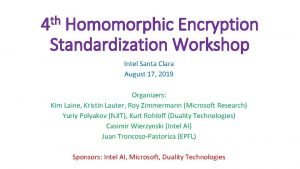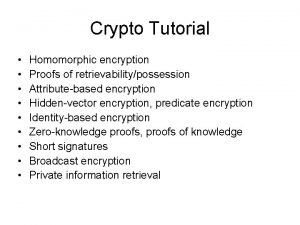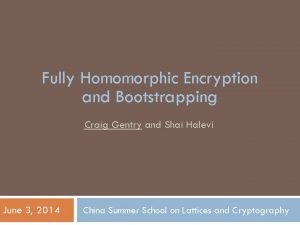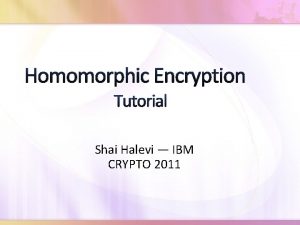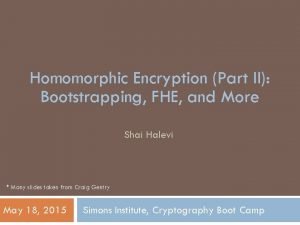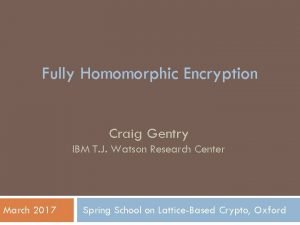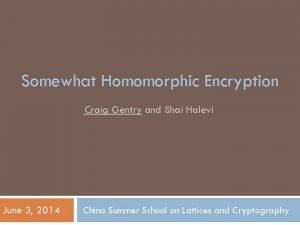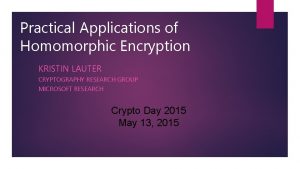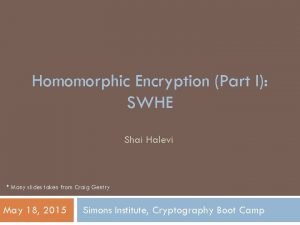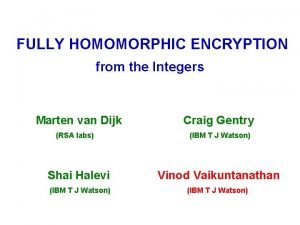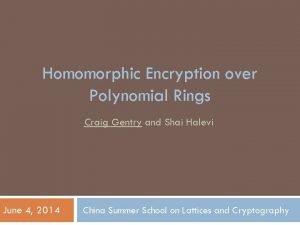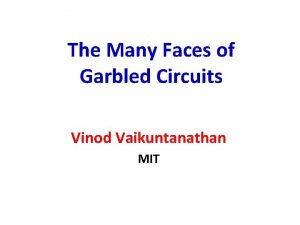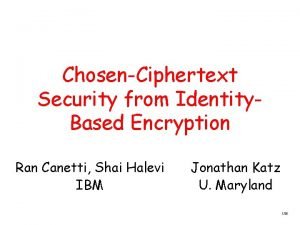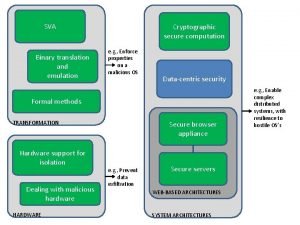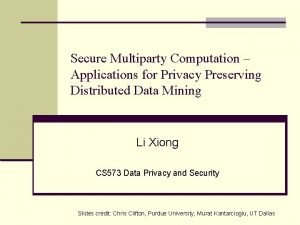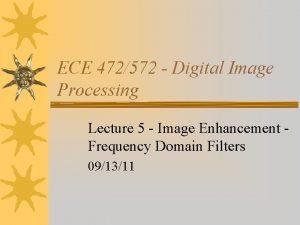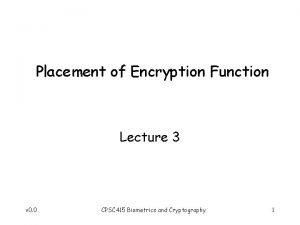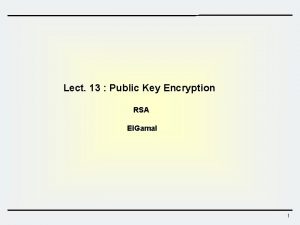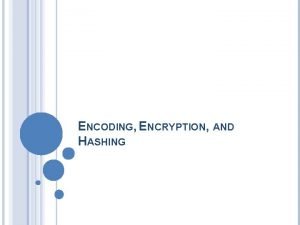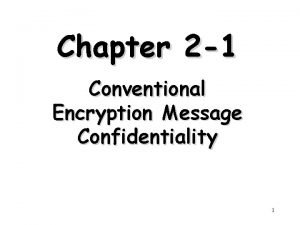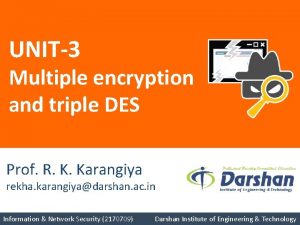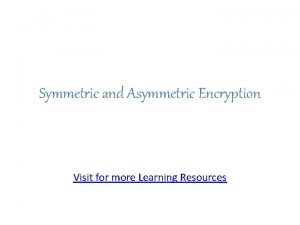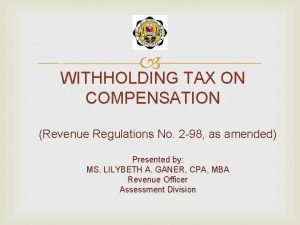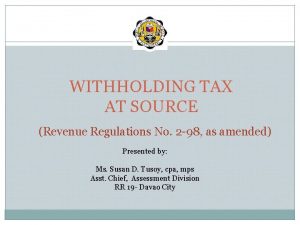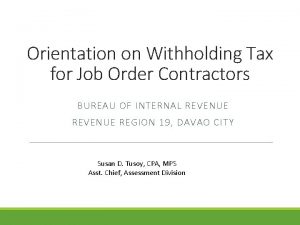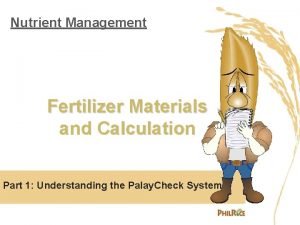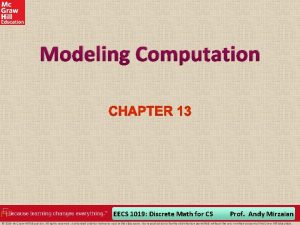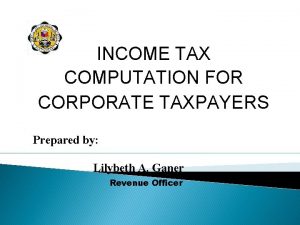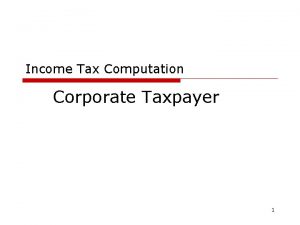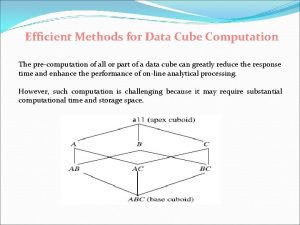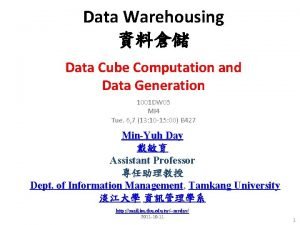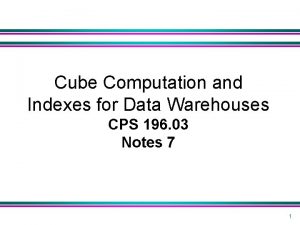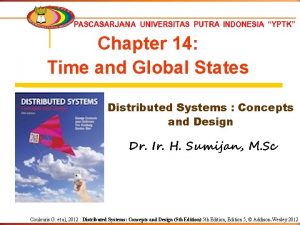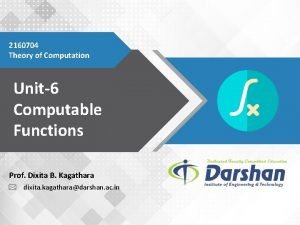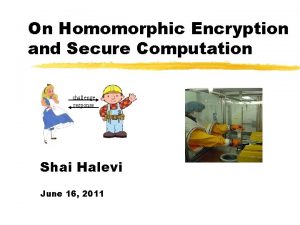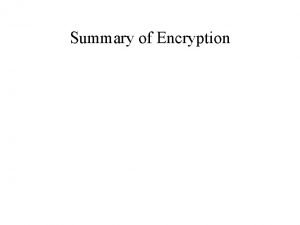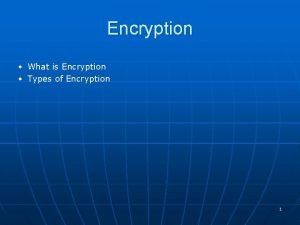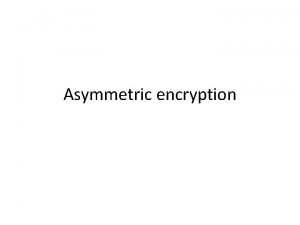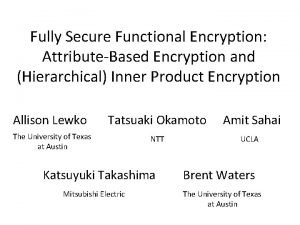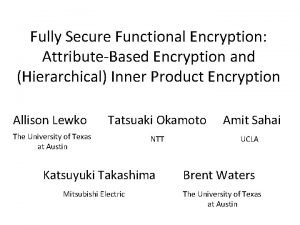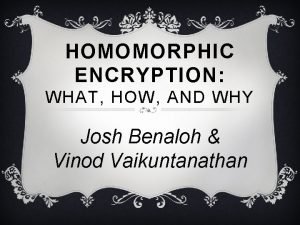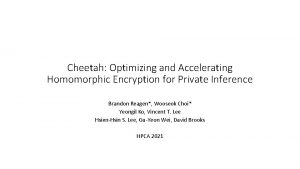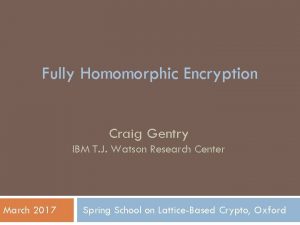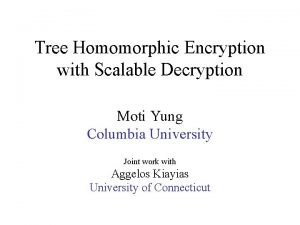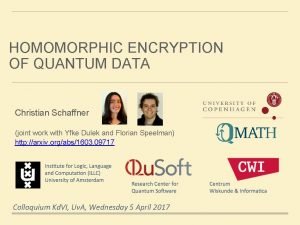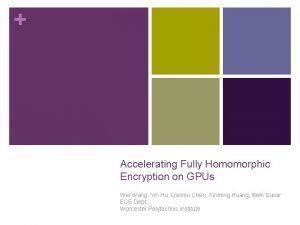On Homomorphic Encryption and Secure Computation challenge response






![Privacy Homomorphisms [RAD 78] Plaintext space P x 1 x 2 ci Enc(xi) Ciphertext Privacy Homomorphisms [RAD 78] Plaintext space P x 1 x 2 ci Enc(xi) Ciphertext](https://slidetodoc.com/presentation_image_h2/1361b004795f2e603a8c1fd0344c73ca/image-7.jpg)
![More Privacy Homomorphisms o Mult-mod-p [El. Gamal’ 84] o Add-mod-N [Pallier’ 98] o NC More Privacy Homomorphisms o Mult-mod-p [El. Gamal’ 84] o Add-mod-N [Pallier’ 98] o NC](https://slidetodoc.com/presentation_image_h2/1361b004795f2e603a8c1fd0344c73ca/image-8.jpg)



![(x, +)-Homomorphic Encryption, the Gentry Way [G’ 09] Evaluate any function in four “easy” (x, +)-Homomorphic Encryption, the Gentry Way [G’ 09] Evaluate any function in four “easy”](https://slidetodoc.com/presentation_image_h2/1361b004795f2e603a8c1fd0344c73ca/image-12.jpg)


![An Example: Integers mod p (similar to [Regev’ 03]) p N o Code determined An Example: Integers mod p (similar to [Regev’ 03]) p N o Code determined](https://slidetodoc.com/presentation_image_h2/1361b004795f2e603a8c1fd0344c73ca/image-15.jpg)



![Integers Rings [v. DGHV’ 10] o Recall mod-p scheme: ci = qip + 2 Integers Rings [v. DGHV’ 10] o Recall mod-p scheme: ci = qip + 2](https://slidetodoc.com/presentation_image_h2/1361b004795f2e603a8c1fd0344c73ca/image-19.jpg)
![Integers Rings [v. DGHV’ 10] Thm: “Approximate GCD” is hard Enc(0), Enc(1) are indistinguishable Integers Rings [v. DGHV’ 10] Thm: “Approximate GCD” is hard Enc(0), Enc(1) are indistinguishable](https://slidetodoc.com/presentation_image_h2/1361b004795f2e603a8c1fd0344c73ca/image-20.jpg)
![Polynomial Rings [G’ 09] o R = polynomial ring modulo some f(x) ØE. g. Polynomial Rings [G’ 09] o R = polynomial ring modulo some f(x) ØE. g.](https://slidetodoc.com/presentation_image_h2/1361b004795f2e603a8c1fd0344c73ca/image-21.jpg)
![Polynomial Rings [G’ 09] Thm: Bounded-Distance Decoding in ideal lattices is hard Enc(0), Enc(1) Polynomial Rings [G’ 09] Thm: Bounded-Distance Decoding in ideal lattices is hard Enc(0), Enc(1)](https://slidetodoc.com/presentation_image_h2/1361b004795f2e603a8c1fd0344c73ca/image-22.jpg)
![*Doesn’t quite fit the mold Matrix Rings* [GHV’ 10] o R = ring of *Doesn’t quite fit the mold Matrix Rings* [GHV’ 10] o R = ring of](https://slidetodoc.com/presentation_image_h2/1361b004795f2e603a8c1fd0344c73ca/image-23.jpg)
![*Doesn’t quite fit the mold Matrix Rings* [GHV’ 10] Thm: Learning with Errors hard *Doesn’t quite fit the mold Matrix Rings* [GHV’ 10] Thm: Learning with Errors hard](https://slidetodoc.com/presentation_image_h2/1361b004795f2e603a8c1fd0344c73ca/image-24.jpg)
![Step 3: Bootstrapping [G’ 09] o So far, can evaluate low-degree polynomials x 1 Step 3: Bootstrapping [G’ 09] o So far, can evaluate low-degree polynomials x 1](https://slidetodoc.com/presentation_image_h2/1361b004795f2e603a8c1fd0344c73ca/image-25.jpg)
![Step 3: Bootstrapping [G’ 09] o So far, can evaluate low-degree polynomials x 1 Step 3: Bootstrapping [G’ 09] o So far, can evaluate low-degree polynomials x 1](https://slidetodoc.com/presentation_image_h2/1361b004795f2e603a8c1fd0344c73ca/image-26.jpg)
![Step 3: Bootstrapping [G’ 09] o So far, can evaluate low-degree polynomials x 1 Step 3: Bootstrapping [G’ 09] o So far, can evaluate low-degree polynomials x 1](https://slidetodoc.com/presentation_image_h2/1361b004795f2e603a8c1fd0344c73ca/image-27.jpg)
![Step 3: Bootstrapping [G’ 09] o Include in the public key also Encpk(sk) x Step 3: Bootstrapping [G’ 09] o Include in the public key also Encpk(sk) x](https://slidetodoc.com/presentation_image_h2/1361b004795f2e603a8c1fd0344c73ca/image-28.jpg)
![Step 3: Bootstrapping [G’ 09] o Include in the public key also Encpk(sk) x Step 3: Bootstrapping [G’ 09] o Include in the public key also Encpk(sk) x](https://slidetodoc.com/presentation_image_h2/1361b004795f2e603a8c1fd0344c73ca/image-29.jpg)
![Step 4: Everything Else o Cryptosystems from [G’ 09, v. DGHV’ 10] cannot handle Step 4: Everything Else o Cryptosystems from [G’ 09, v. DGHV’ 10] cannot handle](https://slidetodoc.com/presentation_image_h2/1361b004795f2e603a8c1fd0344c73ca/image-30.jpg)


![Two-Message SFE [Yao’ 82, …] Alice(x) (c, s) SFE 1(x) y SFE 3(s, r) Two-Message SFE [Yao’ 82, …] Alice(x) (c, s) SFE 1(x) y SFE 3(s, r)](https://slidetodoc.com/presentation_image_h2/1361b004795f2e603a8c1fd0344c73ca/image-33.jpg)






![A More Complex Setting: i-Hop HE [GHV 10 b] Alice(x) c 0 Enc(x) Bob(f) A More Complex Setting: i-Hop HE [GHV 10 b] Alice(x) c 0 Enc(x) Bob(f)](https://slidetodoc.com/presentation_image_h2/1361b004795f2e603a8c1fd0344c73ca/image-40.jpg)






- Slides: 46

On Homomorphic Encryption and Secure Computation challenge response Shai Halevi IBM|NYU|Columbia Theory Day, May 7, 2010 IBM|NYU|Columbia Theory Day

Computing on Encrypted Data Wouldn’t it be nice to be able to… o Encrypt my data in the cloud o While still allowing the cloud to search/sort/edit/… this data on my behalf o Keeping the data in the cloud in encrypted form Ø Without needing to ship it back and forth to be decrypted May 7, 2010 IBM|NYU|Columbia Theory Day 2

Computing on Encrypted Data Wouldn’t it be nice to be able to… o Encrypt my queries to the cloud o While still allowing the cloud to process them o Cloud returns encrypted answers Ø that I can decrypt May 7, 2010 IBM|NYU|Columbia Theory Day 3

Computing on Encrypted Data Directions • From: 19 Skyline Drive, Hawothorne, NY 10532, USA • To: Columbia University May 7, 2010 $skj#h. S 28 ksyt. A@ … IBM|NYU|Columbia Theory Day 4

Computing on Encrypted Data typo May 7, 2010 IBM|NYU|Columbia Theory Day $kjh 9*mslt@na 0 &ma. Xxjq 02 bflx m^00 a 2 nm 5, A 4. p. E. abxp 3 m 58 bsa (3 sa. M%w, snanba nq~m. D=3 akm 2, A Z, ltnhde 83|3 mz{n dewiunb 4]gnb. Ta* kjew^bw. J^mdns 0 5

Part I: Constructing Homomorphic Encryption May 7, 2010 IBM|NYU|Columbia Theory Day
![Privacy Homomorphisms RAD 78 Plaintext space P x 1 x 2 ci Encxi Ciphertext Privacy Homomorphisms [RAD 78] Plaintext space P x 1 x 2 ci Enc(xi) Ciphertext](https://slidetodoc.com/presentation_image_h2/1361b004795f2e603a8c1fd0344c73ca/image-7.jpg)
Privacy Homomorphisms [RAD 78] Plaintext space P x 1 x 2 ci Enc(xi) Ciphertext space C c 1 * c 2 # y Dec(d) y d Some examples: o “Raw RSA”: c xe mod N (x cd mod N) Ø x 1 e x x 2 e = (x 1 x x 2)e mod N o GM 84: Enc(0) R QR, Enc(1) R QNR (in ZN*) Ø Enc(x 1) x Enc(x 2) = Enc(x 1 x 2) mod N May 7, 2010 IBM|NYU|Columbia Theory Day 7
![More Privacy Homomorphisms o Multmodp El Gamal 84 o AddmodN Pallier 98 o NC More Privacy Homomorphisms o Mult-mod-p [El. Gamal’ 84] o Add-mod-N [Pallier’ 98] o NC](https://slidetodoc.com/presentation_image_h2/1361b004795f2e603a8c1fd0344c73ca/image-8.jpg)
More Privacy Homomorphisms o Mult-mod-p [El. Gamal’ 84] o Add-mod-N [Pallier’ 98] o NC 1 circuits [SYY’ 00] o Quadratic-polys mod p [BGN’ 06] o Poly-size branching programs [IP’ 07] o See Part II for a “different type of solution” for any poly-size circuit [Yao’ 82, …] May 7, 2010 IBM|NYU|Columbia Theory Day 8

(x, +)-Homomorphic Encryption It will be really nice to have… o Plaintext space Z 2 (w/ ops +, x) o Ciphertext space some ring R (w/ ops +, x) o Homomorphic for both + and x Ø Enc(x 1) + Enc(x 2) in R = Enc(x 1+ x 2 mod 2) Ø Enc(x 1) x Enc(x 2) in R = Enc(x 1 x x 2 mod 2) o Then we can compute any function on the encryptions Ø Since every binary function is a polynomial o We won’t get exactly this, but it’s a good motivation May 7, 2010 IBM|NYU|Columbia Theory Day 9

Some Notations o An encryption scheme: (Key. Gen, Enc, Dec) ØPlaintext-space = {0, 1} Ø(pk, sk) Key. Gen($), c Encpk(b), b Decsk(c) o Semantic security [GM’ 84]: (pk, Encpk(0)) (pk, Encpk(1)) means indistinguishable by efficient algorithms May 7, 2010 IBM|NYU|Columbia Theory Day 10

Homomorphic Encryption o H = {Key. Gen, Enc, Dec, Eval} c* Evalpk(f, c) o Homomorphic: Decsk(Evalpk( f, Encpk(x))) = f(x) Ø (“Fully” Homomorphic: for every function f ) Ø Encpk(f(x)), Evalpk(f, Encpk(x)) may differ § As long as both distributions decrypt to f(x) o Function-private: Evalpk(f, Encpk(x)) hides f o Compact: |Evalpk(f, Encpk(x))| independent of |f| May 7, 2010 IBM|NYU|Columbia Theory Day 11
![x Homomorphic Encryption the Gentry Way G 09 Evaluate any function in four easy (x, +)-Homomorphic Encryption, the Gentry Way [G’ 09] Evaluate any function in four “easy”](https://slidetodoc.com/presentation_image_h2/1361b004795f2e603a8c1fd0344c73ca/image-12.jpg)
(x, +)-Homomorphic Encryption, the Gentry Way [G’ 09] Evaluate any function in four “easy” steps o Step 1: Encryption from linear ECCs Ø Additive homomorphism o Step 2: ECC lives inside a ring Ø Also multiplicative homomorphism Ø But only for a few operations (i. e. , low-degree poly’s) o Step 3: Bootstrapping Ø Few ops (but not too few) any number of ops o Step 4: Everything else May 7, 2010 IBM|NYU|Columbia Theory Day 12

Step One: Encryption from Linear ECCs o For “random looking” codes, hard to distinguish close/far from code o Many cryptosystems built on this hardness ØE. g. , [Mc. Eliece’ 78, AD’ 97, GGH’ 97, R’ 03, …] May 7, 2010 IBM|NYU|Columbia Theory Day 13

Encryption from linear ECCs o Key. Gen: choose a “random” code C ØSecret key: “good representation” of C § Allows correction of “large” errors ØPublic key: “bad representation” of C o Enc(0): a word close to C o Enc(1): a random word ØFar from C (with high probability) May 7, 2010 IBM|NYU|Columbia Theory Day 14
![An Example Integers mod p similar to Regev 03 p N o Code determined An Example: Integers mod p (similar to [Regev’ 03]) p N o Code determined](https://slidetodoc.com/presentation_image_h2/1361b004795f2e603a8c1fd0344c73ca/image-15.jpg)
An Example: Integers mod p (similar to [Regev’ 03]) p N o Code determined by an integer p ØCodewords: multiples of p o Good representation: p itself o Bad representation: ri p ØN = pq, and also many xi = pqi + ri o Enc(0): subset-sum(xi’s)+r mod N o Enc(1): random integer mod N May 7, 2010 IBM|NYU|Columbia Theory Day 15

A Different Input Encoding o Plaintext bit is LSB of dist(c, C) ØEnc(0/1): close to C , distance is even/odd ØIn our example of integers mod p: § Enc(b) = 2(subset-sum(xi’s)+r) +b mod N § Dec(c) = (c mod p) mod 2 p is odd o Thm: If “C co-prime with 2”, then Enc(0), Enc(1) indistinguishable Øw is near-C/random 2 w+b is Enc(b)/random May 7, 2010 IBM|NYU|Columbia Theory Day 16

Additive Homomorphism o c 1+c 2 = (codeword 1+codeword 2) +2(r 1+r 2)+b 1+b 2 Øcodeword 1+codeword 2 C ØIf 2(r 1+r 2)+b 1+b 2 < min-dist/2, then it is the distance between c 1+c 2 and C Ødist(c 1+c 2, C) = b 1+b 2 mod 2 o Additively-homomorphic while close to C May 7, 2010 IBM|NYU|Columbia Theory Day 17

Step 2: ECC Lives in a Ring R o What happens when multiplying in R: Øc 1 c 2 = (codeword 1+2 r 1+b 1) x (codeword 2+2 r 2+b 2) = codeword 1 X + Y codeword 2 C is both a left-ideal + (2 r 1+b 1)(2 r 2+b 2) and a right-ideal o If: Øcodeword 1 X + Y codeword 2 C Ø (2 r 1+b 1)(2 r 2+b 2) < min-dist/2 o Then Product in R of small elements is small Ødist(c 1 c 2, C) = (2 r 1+b 1)(2 r 2+b 2) = b 1 b 2 mod 2 May 7, 2010 IBM|NYU|Columbia Theory Day 18
![Integers Rings v DGHV 10 o Recall modp scheme ci qip 2 Integers Rings [v. DGHV’ 10] o Recall mod-p scheme: ci = qip + 2](https://slidetodoc.com/presentation_image_h2/1361b004795f2e603a8c1fd0344c73ca/image-19.jpg)
Integers Rings [v. DGHV’ 10] o Recall mod-p scheme: ci = qip + 2 ri+bi (mod N=qp) Ø Parameters: |ri|=n, |p|=n 2, |q|=|qi|=n 5 o c 1+c 2 mod N = (q 1+q 2 -kq)p + 2(r 1+r 2)+(b 1+b 2) sum mod p = 2(r 1+r 2) + (b 1+b 2) o c 1 x c 2 mod N = (c 1 q 2+q 1 c 2 -q 1 q 2 -kq)p + 2(2 r 1 r 2+r 1 m 2+m 1 r 2) + b 1 b 2 product mod p = 2(2 r 1 r 2+…) + b 1 b 2 o Can evaluate polynomials of degree ~ n before the distance from C exceeds p/2 May 7, 2010 IBM|NYU|Columbia Theory Day 19
![Integers Rings v DGHV 10 Thm Approximate GCD is hard Enc0 Enc1 are indistinguishable Integers Rings [v. DGHV’ 10] Thm: “Approximate GCD” is hard Enc(0), Enc(1) are indistinguishable](https://slidetodoc.com/presentation_image_h2/1361b004795f2e603a8c1fd0344c73ca/image-20.jpg)
Integers Rings [v. DGHV’ 10] Thm: “Approximate GCD” is hard Enc(0), Enc(1) are indistinguishable o Apprixmate-GCD: Given N=qp and many xi = pqi + ri, hard to recover p May 7, 2010 IBM|NYU|Columbia Theory Day 20
![Polynomial Rings G 09 o R polynomial ring modulo some fx ØE g Polynomial Rings [G’ 09] o R = polynomial ring modulo some f(x) ØE. g.](https://slidetodoc.com/presentation_image_h2/1361b004795f2e603a8c1fd0344c73ca/image-21.jpg)
Polynomial Rings [G’ 09] o R = polynomial ring modulo some f(x) ØE. g. , f(x) = xn +1 o C is an ideal in R ØE. g. , random g(x), Cg = { gxh mod f : h R } § C is also a lattice ØGood representation: g itself ØBad representation: Hermite-Normal-Form o If g has t-bit coefficients, can evaluate polynomials of degree O(t/log n) May 7, 2010 IBM|NYU|Columbia Theory Day 21
![Polynomial Rings G 09 Thm BoundedDistance Decoding in ideal lattices is hard Enc0 Enc1 Polynomial Rings [G’ 09] Thm: Bounded-Distance Decoding in ideal lattices is hard Enc(0), Enc(1)](https://slidetodoc.com/presentation_image_h2/1361b004795f2e603a8c1fd0344c73ca/image-22.jpg)
Polynomial Rings [G’ 09] Thm: Bounded-Distance Decoding in ideal lattices is hard Enc(0), Enc(1) are indistinguishable o Bounded-Distance-Decoding: Given x close to the lattice, find dist(x, lattice) May 7, 2010 IBM|NYU|Columbia Theory Day 22
![Doesnt quite fit the mold Matrix Rings GHV 10 o R ring of *Doesn’t quite fit the mold Matrix Rings* [GHV’ 10] o R = ring of](https://slidetodoc.com/presentation_image_h2/1361b004795f2e603a8c1fd0344c73ca/image-23.jpg)
*Doesn’t quite fit the mold Matrix Rings* [GHV’ 10] o R = ring of mxm matrices over Zq Ø o q = poly(n), m > n log q (n security-parameter) C has low-rank matrices mod q (rank=n) ØA is a random nxm matrix, CA = { AX : X R } ØBad representation: A itself ØGood representation: full rank Tmxm (over Z), small entries, TA = 0 mod q • Problem: CA is left-ideal, but not right-ideal • Can still evaluate quadratic formulas, no more May 7, 2010 IBM|NYU|Columbia Theory Day 23
![Doesnt quite fit the mold Matrix Rings GHV 10 Thm Learning with Errors hard *Doesn’t quite fit the mold Matrix Rings* [GHV’ 10] Thm: Learning with Errors hard](https://slidetodoc.com/presentation_image_h2/1361b004795f2e603a8c1fd0344c73ca/image-24.jpg)
*Doesn’t quite fit the mold Matrix Rings* [GHV’ 10] Thm: Learning with Errors hard Enc(0), Enc(1) are indistinguishable o Learning with Errors: Given A, Ax+e (random A, x, small error e), find x May 7, 2010 IBM|NYU|Columbia Theory Day 24
![Step 3 Bootstrapping G 09 o So far can evaluate lowdegree polynomials x 1 Step 3: Bootstrapping [G’ 09] o So far, can evaluate low-degree polynomials x 1](https://slidetodoc.com/presentation_image_h2/1361b004795f2e603a8c1fd0344c73ca/image-25.jpg)
Step 3: Bootstrapping [G’ 09] o So far, can evaluate low-degree polynomials x 1 x 2 … P P(x 1, x 2 , …, xt) xt May 7, 2010 IBM|NYU|Columbia Theory Day 25
![Step 3 Bootstrapping G 09 o So far can evaluate lowdegree polynomials x 1 Step 3: Bootstrapping [G’ 09] o So far, can evaluate low-degree polynomials x 1](https://slidetodoc.com/presentation_image_h2/1361b004795f2e603a8c1fd0344c73ca/image-26.jpg)
Step 3: Bootstrapping [G’ 09] o So far, can evaluate low-degree polynomials x 1 x 2 … P P(x 1, x 2 , …, xt) xt o Can eval y=P(x 1, x 2…, xn) when xi’s are “fresh” o But y is an “evaluated ciphertext” ØCan still be decrypted ØBut eval Q(y) will increase noise too much May 7, 2010 IBM|NYU|Columbia Theory Day 26
![Step 3 Bootstrapping G 09 o So far can evaluate lowdegree polynomials x 1 Step 3: Bootstrapping [G’ 09] o So far, can evaluate low-degree polynomials x 1](https://slidetodoc.com/presentation_image_h2/1361b004795f2e603a8c1fd0344c73ca/image-27.jpg)
Step 3: Bootstrapping [G’ 09] o So far, can evaluate low-degree polynomials x 1 x 2 … P P(x 1, x 2 , …, xt) xt o Bootstrapping to handle higher degrees: o For ciphertext c, consider Dc(sk) = Decsk(c) ØHope: Dc(*) is a low-degree polynomial in sk ØThen so are Ac 1, c 2(sk) = Decsk(c 1) + Decsk(c 2) and Mc 1, c 2(sk) = Decsk(c 1) x Decsk(c 2) May 7, 2010 IBM|NYU|Columbia Theory Day 27
![Step 3 Bootstrapping G 09 o Include in the public key also Encpksk x Step 3: Bootstrapping [G’ 09] o Include in the public key also Encpk(sk) x](https://slidetodoc.com/presentation_image_h2/1361b004795f2e603a8c1fd0344c73ca/image-28.jpg)
Step 3: Bootstrapping [G’ 09] o Include in the public key also Encpk(sk) x 1 c 1 sk 2 … skn May 7, 2010 x 2 c 2 Requires “circular security” Mc 1, c 2 c Mc 1, c 2(sk) = Decsk(c 1) x Decsk(c 2) = x 1 x x 2 IBM|NYU|Columbia Theory Day 28
![Step 3 Bootstrapping G 09 o Include in the public key also Encpksk x Step 3: Bootstrapping [G’ 09] o Include in the public key also Encpk(sk) x](https://slidetodoc.com/presentation_image_h2/1361b004795f2e603a8c1fd0344c73ca/image-29.jpg)
Step 3: Bootstrapping [G’ 09] o Include in the public key also Encpk(sk) x 1 c 1 sk 2 … skn x 2 c 2 Requires “circular security” Mc 1, c 2 c Mc 1, c 2(sk) = Decsk(c 1) x Decsk(c 2) = x 1 x x 2 o Homomorphic computation applied only to the “fresh” encryption of sk May 7, 2010 IBM|NYU|Columbia Theory Day 29
![Step 4 Everything Else o Cryptosystems from G 09 v DGHV 10 cannot handle Step 4: Everything Else o Cryptosystems from [G’ 09, v. DGHV’ 10] cannot handle](https://slidetodoc.com/presentation_image_h2/1361b004795f2e603a8c1fd0344c73ca/image-30.jpg)
Step 4: Everything Else o Cryptosystems from [G’ 09, v. DGHV’ 10] cannot handle their own decryption as-is o Apply some tricks to “squash” the decryption procedure May 7, 2010 IBM|NYU|Columbia Theory Day 30

Part II: Homomorphic Encryption vs. Secure Computation May 7, 2010 IBM|NYU|Columbia Theory Day

Secure Function Evaluation (SFE) Client Alice has data x Server Bob has function f Alice wants to learn f(x) 1. Without telling Bob what x is 2. Bob may not want Alice to know f 3. Client Alice may also want server Bob to do most of the work computing f(x) May 7, 2010 IBM|NYU|Columbia Theory Day 32
![TwoMessage SFE Yao 82 Alicex c s SFE 1x y SFE 3s r Two-Message SFE [Yao’ 82, …] Alice(x) (c, s) SFE 1(x) y SFE 3(s, r)](https://slidetodoc.com/presentation_image_h2/1361b004795f2e603a8c1fd0344c73ca/image-33.jpg)
Two-Message SFE [Yao’ 82, …] Alice(x) (c, s) SFE 1(x) y SFE 3(s, r) Bob(f) c r r SFE 2(f, c) o Many different instantiations are available Ø Based on hardness of factoring/DL/lattices/… o Alice’s x and Bob’s f are kept private o But Alice does as much work as Bob Ø Bob’s reply of size poly(n) x (|f|+|x|) May 7, 2010 IBM|NYU|Columbia Theory Day 33

Recall: Homomorphic Encryption o H = {Key. Gen, Enc, Dec, Eval} o Semantic security: (pk, Encpk(0)) (pk, Encpk(1)) o Homomorphic: Decsk(Evalpk( f, Encpk(x))) = f(x) Ø (“Fully” Homomorphic: for every function f ) Ø Encpk(f(x)), Evalpk(f, Encpk(x)) may differ § As long as both distributions decrypt to f(x) o Function-private: Evalpk(f, Encpk(x)) hides f o Compact: |Evalpk(f, Encpk(x))| independent of |f| May 7, 2010 IBM|NYU|Columbia Theory Day 34

Aside: a Trivial Solution o Eval(f, c) = <f, c>, Dec*(<f, c>) = f (Dec(c)) o Neither function-private, nor compact o Not very useful in applications May 7, 2010 IBM|NYU|Columbia Theory Day 35

HE Two-Message SFE o Alice encrypts data x Øsends to Bob c Enc(x) o Bob computes on encrypted data Øsets c* Eval(f, c) Øc* is supposed to be an encryption of f(x) ØHopefully it hides f (function-private scheme) o Alice decrypts, recovers y Dec(c*) May 7, 2010 IBM|NYU|Columbia Theory Day 36

Two-Message SFE HE o Roughly: ØAlice’s message c SFE 1(x) is Enc(x) ØBob’s reply r SFE 2(f, c) is Eval(f, c) o Not quite public-key encryption yet ØWhere are (pk, sk)? ØCan be fixed with an auxiliary PKE scheme May 7, 2010 IBM|NYU|Columbia Theory Day 37

Two-Message SFE HE Alice(pk, Alice(x)x) (c, s) SFE 1(x) y SFE 3(s, r) Bob(f) Dora(sk) c r r SFE 2(f, c) o Add an auxiliary encryption scheme Øwith (pk, sk) May 7, 2010 IBM|NYU|Columbia Theory Day 38

Two-Message SFE HE Alice(pk, x) (c, s) SFE 1(x) c’ Encpk(s) Bob(f) Dora(sk) c, c’ Enc’pk(x) r SFE 2(f, c) Evalpk(f, c, c’) r, c’ s Decsk(c’) y SFE 3(s, r) Decsk(r, c’) o Recall: |r| could be as large as poly(n)(|f|+|x|) Ø Not compact May 7, 2010 IBM|NYU|Columbia Theory Day 39
![A More Complex Setting iHop HE GHV 10 b Alicex c 0 Encx Bobf A More Complex Setting: i-Hop HE [GHV 10 b] Alice(x) c 0 Enc(x) Bob(f)](https://slidetodoc.com/presentation_image_h2/1361b004795f2e603a8c1fd0344c73ca/image-40.jpg)
A More Complex Setting: i-Hop HE [GHV 10 b] Alice(x) c 0 Enc(x) Bob(f) c 0 Charlie(g) c 1 Eval(f, c 0) c 1 c 2 Eval(g, c 1) Dora(sk) c 2 y Dec(c 2) 2 -Hop Homomorphic Encryption o c 1 is not a fresh ciphertext Ø May look completely different o Can Charlie process it at all? Ø What about security? May 7, 2010 IBM|NYU|Columbia Theory Day 40

Multi-Hop Homomorphic Encryption o H = {Key. Gen, Enc, Eval, Dec} as before o i-Hop Homomorphic (i is a parameter) x Encpk(x) c 0 Evalpk(f 1, c 0) c 1 Evalpk(f 2, c 1) c 2 … cj Decsk(x) y Any number j i hops Ø y = fj(fj-1(… f 1(x) …)) for any x, f 1, …, fj o Similarly for i-Hop function-privacy, compactness o Multi-Hop: i-Hop for any i May 7, 2010 IBM|NYU|Columbia Theory Day 41

1 -Hop multi-Hop HE o (Key. Gen, Enc, Eval, Dec) is 1 -Hop HE ØCan evaluate any single function on ctxt o We have c 1=Evalpk(f 1, c 0), and some other f 2 Bootstrapping: o Include with pk also c*=Encpk(sk) o Consider Fc , f (sk) = f 2( Decsk(c 1) ) 1 2 ØLet c 2=Evalpk(Fc , f , c*) 1 May 7, 2010 2 IBM|NYU|Columbia Theory Day 42

1 -Hop multi-Hop HE c* fi ci-1 sk xi-1 Fci-1, fi ci+1 Fc , f (sk) = fi( Decsk(ci-1) ) = fi(xi-1) i-1 i o Drawback: |ci| grows exponentially with i: Ø |Fc , f | |ci-1|+| fi| Ø |ci|= |Evalpk(Fc , f , c*)| poly(n)(|ci-1|+| fi|) i-1 i o Does not happen if underlying scheme is compact Or even |Evalpk(Fc May 7, 2010 i-1, fi , c*)| = |ci-1|+poly(n)| fi| IBM|NYU|Columbia Theory Day 43

Other Constructions o Private 1 -hop HE + Compact 1 -hop HE Compact, Private multi-hop HE o A direct construction of multi-hop HE from Yao’s protocol May 7, 2010 IBM|NYU|Columbia Theory Day 44

Summary o Homomorphic Encryption is useful ØEspecially multi-hop HE o A method for constructing HE schemes from linear ECCs in rings ØTwo (+e) known instances so far o Connection to two-message protocols for secure computation May 7, 2010 IBM|NYU|Columbia Theory Day 45

Thank You May 7, 2010 IBM|NYU|Columbia Theory Day
 Homomorphic encryption standard
Homomorphic encryption standard Homomorphic encryption tutorial
Homomorphic encryption tutorial Homomorphic encryption tutorial
Homomorphic encryption tutorial Craig gentry homomorphic encryption
Craig gentry homomorphic encryption Homomorphic encryption tutorial
Homomorphic encryption tutorial Gsw homomorphic encryption
Gsw homomorphic encryption Craig gentry ibm
Craig gentry ibm Somewhat homomorphic encryption
Somewhat homomorphic encryption Applications for homomorphic encryption
Applications for homomorphic encryption Homomorphic encryption
Homomorphic encryption Pq0p
Pq0p Craig gentry homomorphic encryption
Craig gentry homomorphic encryption Functional encryption
Functional encryption Homomorphic encryption
Homomorphic encryption Binary search in secure computation
Binary search in secure computation Secure multiparty computation
Secure multiparty computation Welcome to teen challenge uk - teen challenge uk
Welcome to teen challenge uk - teen challenge uk Homomorphic filtering block diagram
Homomorphic filtering block diagram Natural response and forced response
Natural response and forced response Natural response circuit
Natural response circuit A subsequent
A subsequent Explain about the placement of encryption function
Explain about the placement of encryption function Rsa crittografia
Rsa crittografia Encoding and encryption
Encoding and encryption Conventional encryption and message confidentiality
Conventional encryption and message confidentiality Block ciphers and the data encryption standard
Block ciphers and the data encryption standard Multiple encryption and triple des
Multiple encryption and triple des Advantages of asymmetric encryption
Advantages of asymmetric encryption Tax due formula
Tax due formula Expanded withholding tax computation
Expanded withholding tax computation Expanded withholding tax computation
Expanded withholding tax computation Expanded withholding tax computation
Expanded withholding tax computation Fertilizer computation examples
Fertilizer computation examples Modeling computation discrete math
Modeling computation discrete math Sipser, m: introduction to the theory of computation
Sipser, m: introduction to the theory of computation How to compute iaet
How to compute iaet Income tax computation format
Income tax computation format Pediatric dehydration fluid replacement formula
Pediatric dehydration fluid replacement formula Efilingofincometax
Efilingofincometax Data cube computation
Data cube computation Drug calculation formula
Drug calculation formula Data cube computation
Data cube computation Index de computation
Index de computation How to calculate flow rate iv
How to calculate flow rate iv Cuts of a distributed computation
Cuts of a distributed computation Theory of computation
Theory of computation Expanded withholding tax computation
Expanded withholding tax computation
